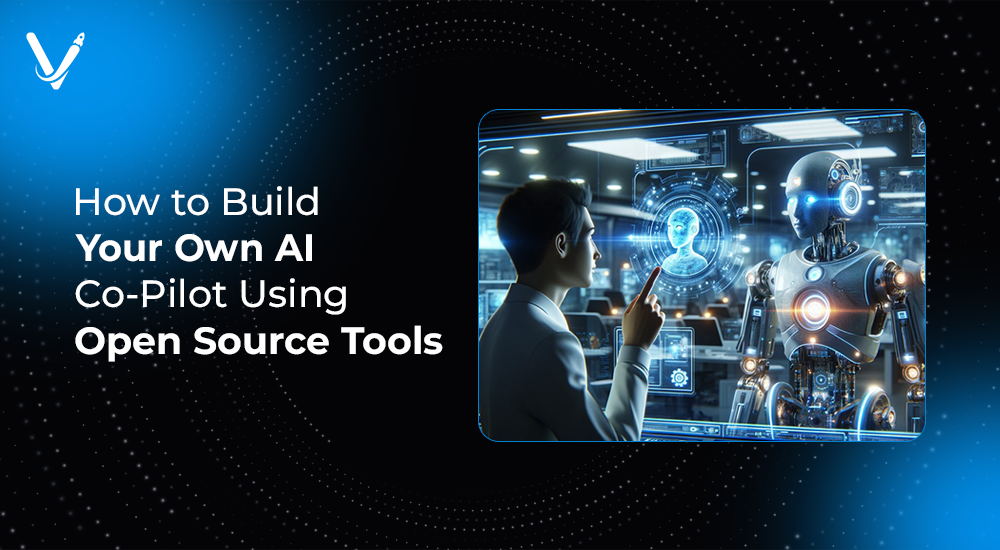AI copilots have emerged as game-changers in the tech industry, assisting users with complex tasks, improving productivity, and transforming user experiences. Building a custom AI co-pilot using open source tools can provide tailored functionalities without the constraints of proprietary platforms. This comprehensive guide explores how to create your AI co-pilot using open source AI tools and best LLM models, along with actionable steps to bring your vision to life.
Understanding AI Copilots
An AI copilot functions as a digital assistant capable of performing specific tasks through natural language processing and machine learning. Businesses leverage AI copilots to automate routine tasks, provide real-time insights, and streamline decision-making processes.
Benefits of AI Copilots
- Enhanced productivity
- 24/7 availability
- Consistent user experiences
- Cost-effective operations
- Personalized user interactions
Use Cases of AI Copilots
- Customer support automation
- Content generation and marketing
- Data analysis and reporting
- Personalized recommendations
- Workflow management and scheduling
Selecting the Right Open Source Tools
Choosing the right open source tools is critical to the success of your AI copilot project. The tools you select should align with your project’s objectives, budget, and technical requirements.
Recommended Open Source Tools for Building AI Copilots
- LangChain: Modular framework for creating AI-driven applications.
- Hugging Face: Repository of powerful language models and APIs.
- FastAPI: Lightweight web framework for building AI applications.
- OpenLLM: Deployment and scaling of large language models.
- DeepSeek: Specialized in task-oriented AI functionalities.
- Streamlit: Visualization tool for creating interactive AI dashboards.
- Docker: Containerization for scalable deployment.
Integrating Open Source Tools
- Connect Hugging Face models with LangChain for natural language processing.
- Use FastAPI for creating RESTful APIs to handle data requests.
- Deploy LLMs using OpenLLM and containerize with Docker.
Best LLM Models for AI Copilots
Large language models (LLMs) play a pivotal role in AI copilots by powering natural language processing and understanding. Some of the best open source LLM models include:
- GPT-NeoX: High-performance model for text generation and analysis.
- Bloom: Multilingual LLM with extensive training data.
- Falcon: Efficient LLM with optimized data processing.
- DeepSeek R1: Tailored for task-oriented applications and query processing.
Choosing the Right LLM Model
- Assess the complexity of tasks.
- Determine the languages supported by the model.
- Evaluate the computational requirements.
Step-by-Step Guide to Building an AI Co-Pilot
Creating an AI co-pilot involves several phases, from planning and tool selection to implementation and testing.
Step 1: Define the Purpose and Features
Before starting, it is essential to clearly outline the purpose of your AI Co-Pilot. Identify the primary tasks it will perform and the features it should include. For example:
- Task Automation: Managing emails, scheduling, or generating reports.
- Decision Support: Analyzing data and providing recommendations.
- Creative Assistance: Writing, designing, or ideation support.
- Technical Assistance: Coding help or data analysis.
Clearly defining the purpose will guide your technology choices and development path.
Step 2: Choose the Best LLM Model
Selecting the right Large Language Model (LLM) is crucial for building an efficient AI Co-Pilot. Consider the following factors:
- Accuracy and Performance: Models like GPT-4, LLaMA, or Bloom are highly accurate and robust.
- Open Source Options: Opt for models like Open Assistant or GPT-J for more customization.
- Computational Efficiency: Lightweight models like DistilBERT are suitable for limited resources.
- Domain-Specific Needs: Choose models fine-tuned for specific industries (e.g., healthcare, finance).
Integrating the right model can significantly enhance your AI Co-Pilot’s performance.
Step 3: Set Up Your Development Environment
To build your AI Co-Pilot, you need the right tools and platforms:
- Programming Languages: Python is the most popular choice due to its extensive libraries.
- Libraries and Frameworks: Use TensorFlow, PyTorch, or Hugging Face’s Transformers.
- Development Tools: Jupyter Notebook for prototyping, Git for version control, and Docker for containerization.
- Compute Resources: Access to GPU acceleration via cloud services like AWS or Google Colab.
Setting up a robust environment ensures smooth model training and deployment.
Step 4: Collect and Prepare Data
High-quality data is essential for training your AI Co-Pilot. Follow these steps to gather and preprocess data:
- Data Sources: Public datasets, web scraping, or proprietary data.
- Data Cleaning: Remove duplicates, correct inconsistencies, and normalize text.
- Data Labeling: Annotate the data to help the model understand context and relevance.
- Data Augmentation: Enhance dataset variety with techniques like paraphrasing or text generation.
Maintaining data quality throughout the process ensures better model accuracy and reliability.
Step 5: Fine-Tune the LLM
Fine-tuning adapts a pre-trained LLM to your specific use case:
- Data Splitting: Divide data into training, validation, and test sets.
- Training Configuration: Set learning rates, batch size, and model parameters.
- Training Process: Use frameworks like Hugging Face to fine-tune the model.
- Evaluation Metrics: Measure accuracy, F1-score, and loss to monitor progress.
- Model Optimization: Use techniques like pruning or quantization to improve performance.
Successful fine-tuning makes the model more relevant to your AI Co-Pilot’s tasks.
Step 6: Integrate Open Source AI Tools
Enhance your AI Co-Pilot’s capabilities by integrating these open-source tools:
- LangChain: Manages LLM interactions for complex queries.
- Haystack: Allows efficient search and data retrieval.
- Rasa: Adds conversational AI features for interactive applications.
- FastAPI: Creates RESTful APIs to serve your AI Co-Pilot.
Using these tools saves development time while adding powerful features.
Step 7: Develop the Co-Pilot Interface
Creating a user-friendly interface is crucial for practical application:
- Front-End Technologies: React or Angular for building interactive dashboards.
- Backend API: Use Flask or FastAPI to connect the AI model with the front end.
- Integration: Enable voice inputs using libraries like SpeechRecognition.
- Responsive Design: Ensure compatibility with mobile and desktop devices.
A well-designed interface improves user experience and accessibility.
Step 8: Implement Core Functionalities
Based on your use case, implement core functionalities such as:
- Text Summarization: Generate concise reports from lengthy documents.
- Contextual Responses: Maintain conversation flow in chatbot applications.
- Data Insights: Provide analytics and data-driven recommendations.
- Voice Commands: Integrate voice-based inputs for hands-free operations.
Adding essential features makes the AI Co-Pilot truly useful for daily tasks.
Step 9: Testing and Debugging
Rigorous testing ensures your AI Co-Pilot performs reliably:
- Unit Testing: Test individual functions for correctness.
- Integration Testing: Check how components interact.
- Performance Testing: Measure response time and accuracy.
- User Acceptance Testing: Gather feedback from real users.
Identify and fix issues early to ensure a smooth user experience.
Step 10: Deployment and Maintenance
Deploying your AI Co-Pilot requires setting up reliable hosting and maintenance:
- Cloud Hosting: Use AWS EC2, Azure, or Google Cloud for scalability.
- CI/CD Pipeline: Automate deployment with GitHub Actions or Jenkins.
- Monitoring: Set up logging and monitoring for errors and performance.
- Updates: Regularly update the model to maintain accuracy.
Ensuring proper deployment guarantees long-term usability and reliability.
Step 11: Secure Your AI Co-Pilot
Security is vital when dealing with user data and AI interactions:
- Data Encryption: Protect sensitive information using SSL/TLS.
- Access Control: Implement role-based access to safeguard data.
- API Security: Use OAuth and JWT for secure API interactions.
- Anomaly Detection: Detect unusual usage patterns to prevent abuse.
Prioritizing security builds user trust and protects data integrity.
Step 12: Gather User Feedback and Iterate
Post-deployment, user feedback helps improve the AI Co-Pilot:
- Surveys and Reviews: Understand user satisfaction.
- Feature Requests: Identify what users find useful or missing.
- Performance Analysis: Monitor usage statistics to identify bottlenecks.
- Regular Updates: Keep improving based on insights and new technologies.
A feedback-driven approach helps maintain relevance and usability.
Real-World Examples of AI Copilots
- Github Copilot: Assists developers by suggesting code snippets.
- Microsoft Power BI Co-Pilot: Provides data analysis and visualization insights.
- Jasper AI: Generates content and text for marketing campaigns.
- Otter AI: Transcribes meetings and provides actionable summaries.
- Grammarly: Offers writing suggestions based on NLP analysis.
Conclusion
Building an AI co-pilot using open source tools enables businesses to harness the power of advanced AI models without relying on proprietary platforms. With tools like Hugging Face, LangChain, and FastAPI, creating a customized AI assistant is now more accessible than ever. Vasundhara Infotech can help you develop robust AI copilots tailored to your specific needs, ensuring impactful user experiences and streamlined operations.


